Escape compasses were issued to allied pilots, paratroopers, commandos, the regular army and SOE agents as part of escape and evasion kits. For collectors, these compasses are a very exciting subject because of their secret nature. Many myths exist about their issue and use. There is some conjecture as to the actual number of captured airmen and paratroopers who were able to flee from German stalags with the aid of these rudimentary Magnetic North Seeking escape compasses. It is also doubtfull that their German captors were not aware of such devices. In fact, the odds of making a ‘home run’ out of Germany were very slight. Out of 10,000 RAF prisoners, only 30 succeeded in reaching home. The Great Escapes exhibition at the Imperial War Museum in London (until 31 July 2005) shows that plans of escaping was not what occupied most POWs, contrary to what movies like The Great Escape, Stalag 17, Colditz and The Wooden Horse would lead us to believe. Most of all, their creativity was needed not to get crazy.
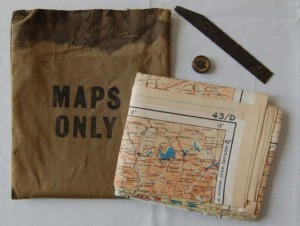
Escape map with pouch, compass and saw blade
This article describes the versions of escape compasses known to exist, assembling detailed descriptions and photographs from collectors around the world. Due to their purpose, they were mostly very small and of rudimentary design. Unlike other military compasses, most of the devices described here lack numerical scales graduated in degrees for determining azimuth. They were also of questionable accuracy. The escapee would have had to rely on other means for determining direction. For example, Polaris, the North Star, could be used for determining geographical North, however, it could be utilized only at night under a clear sky.
Most of these compasses are of British design and manufacture unless otherwise noted. The British made many different types of escape compasses. The reason for having really different models, was to better be able to conceal them in different circumstances. The explanation for making so many different variations of the same type of compass (i.e. the ‘pill box’ type) may be found in the continuous improvement and different manufacturers.
Early type British escape compass
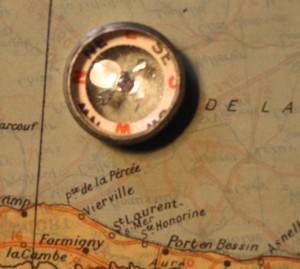
Early British escape compass
This type of escape compass was made by the British before the war, and issued into the first years of the war. Its aluminium body – 0.622″ (15,8 mm) across x 0.287″ (7,3 mm) high – and its more elaborate construction compared to later models confirm this. Aluminium was not used on war time manufactured escape compasses. Instead, brass bodies were the norm, on American, Britsh and foreign models alike. As the war wore on, aluminium had to be saved for aircraft production. For all countries’ we can see aluminium being replaced by iron, steel and brass in all kinds of equipment, such as buckles, canteens and mess tins. The construction can be considered more elaborate, and thus more costly to manufacture, because of several points.
Firstly, the dome-shaped lenses on both sides. On initial inspection, there seems to be no good reason for being able to view and read the compass from both sides. Also the dome-shaped glass might as well have been flat, as on later models. So, why bother? My guess is that the purpose of this lies in the magnifying effect of the two lenses combined. I haven’t tried it out, but it may be possible to start a fire by focussing the sunlight through the lenses.
Secondly, the compass rose. It has eight compass directions printed on a cardboard circle, with the four main directions marked in red. These directions can also be read from both sides. In fact, there are two cardboard circles glued together, back to back. They weren’t glued together with the directions aligned on both sides. If you flip the compass over, the arrow doesn’t point to the same direction.
As for the arrow, it is actually arrow-shaped (instead of most types) and stamped out of blued sheet steel. It is suspended on a pin between both glass lenses. The pin is probably not made of steel – probably brass – but you can’t see it very well because of the deforming effect of the domed-shape lenses. The colour of the pin appears to be blue/black, so it may just as well be steel, but I think its own magnetic field would interfere with that of the arrow.
One last thing that stands out (literally) is the rim of the aluminium casing. On one side, it protrudes where it is crimped to one of the glass covers. None of the other types have this, except the other aluminium type, which is as yet unidentified.
The ‘pill box’ escape compass
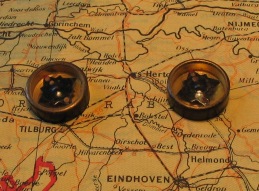
Two pillobox type escape compasses with square card
This is the most common model. Together with escape maps, a hacksaw blade and phrase cards, they were packed in a rubberized canvas map pouch. Soldiers also called it the ‘asshole compass’ because it was so small, you could hide it anywhere… It is cylindrical in shape and consists of a brass shell, 0.60” (15,24 mm) in diameter x 0.19” (4,9 mm) high, with a wall thickness of 0.015” (0,38 mm). The blackened compass card is a non-ferromagnetic material balanced on a brass pivot and encased beneath a swaged-in 0.030” (0,76 mm) thick glass cover. The seal between the glass and the shell is hermetic to prevent the entry and/or entrapment of moisture in the compass chamber. The compass card has points at each corner and at the middle of each edge: eight points in all, set at 45 degree intervals. North is designated by a white dot lined up between a corner of the card and its center. A pair of white dots are located on the opposite corner. The dots have been coated with a luminous material, which, over the years has depleted on most of the examples you see here. The compass card turns freely on its pivot. There is no external means for detenting the card when the compass is not in use, as is common on military field compasses. A small magnet secured to the underside of the card aligns the card with the North Magnetic Pole.
If you look closely at this picture, you will see that one on the left has a bevelled lense, which comes level with the brass casing, whereas the lense of the one on the right is flat and swaged-in. It would appear that these were made by different manufacturers, but of course none of the escape compasses in this article feature any markings.
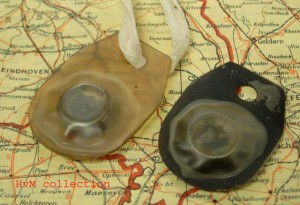
Escape compass in rubber pod
The compass was also issued encapsulated in a transparent soft plastic pod which darkens with age. The pod is 1.75” (44,24 mm) long x 1.25” (31,75 mm) wide and has a 0.25” (6,35 mm) diameter hole at one end for use with a cord for hanging about the neck etc. This casing also allowed the compass to be safely swallowed in case of capture (without a lanyard of course).
The miniature escape compass
The pill box compass was also produced in sizes under 0.25” (6,35 mm) diameter. Such compasses, which have become extremely rare, were concealed inside pencils, pens, and other mundane objects. The one shown here has a 0.15” (3,7 mm) high case with a slightly protrodung domed-shape glass cover. The arrow in this compass is actually arrow-shaped and has luminous dots on either side. In the dark, one might have seen both dots, but I think it would have been very hard to tell which side was the tip of the arrow. A regular pill box compass is shown for comparison.
A modification of the pill box-shaped compass
In these compasses, the squarish eight point compass card was replaced by a 0.45” (11,43 mm) diameter circular card. Four holes at 0.12” (3,05 mm) diameter spaced evenly on a 0.28” (7,11 mm) diameter base circle of the card reduced its mass, hence the inertia, allowing the card to come to rest with a minimum of oscillations. You see here three versions. From left to right: one with a bare metal card with two dots of (luminous) paint, one with a blackened card with two dots of (luminous) paint, one with a chromed card with two embossed dots filled with (luminous) paint and a small stripe of red paint. The one with the bare metal card also has a bevelled lense and is a bit higher than the other ones at 0.22” (5,5 mm). Compasses featuring round cards are scarcer than those with the squarish card. Also note that all three versions are unpainted on the outside.
Tunic button escape compasses
Besides the escape and evasion kits, both types of pill box compasses were also hidden in clothing or other objects. This here is a button from an RAF tunic. The button was made by Firmin of London. The top can be unscrewed to reveal the compass. Later war models had a top that had a reverse thread, so to unscrew them, you had to twist the other way. This was done after the Germans were known to have found out about the existence of this type of compass. Compasses may also be found inside Royal Artillary and Reconnaissance buttons.
They are also known to have been hidden inside shaving brushes, hair brushes, lighters, etc.
Another version of a tunic button escape compass was sent to me in October 2021 by Jim Sadler. He got it from his dad, who was with the Royal Signals. I therefore assume that this is an Army button and not RAF. The compass fits inside the recess of the bottom part of the button, so it doesn’t rattle, and the front of the button screws over it. You can see that its construction is quite different from the RAF tunic button above.
American model
Most escape kit was of British design and manufacture, including the compasses, but they were issued to British and Americans alike. The Americans did make an escape compass of their own, which is less common than the British types. It is different in that it is noticeably larger in diameter 0.73” (18,5 mm) and in that is has a printed compass card with the four compass directions. The advantage of this would have been that there could be no doubt about what indicated North. It has a white line running across the lense, serving the same purpose as the hairline on a normal field compass. The compass is 0.24“ (6 mm) high. This design continued to be manufactured by Waltham after the war with provisions for either a wrist strap or a lanyard.
The ‘Swinger’ type
This type of compass came in pairs wrapped in paper. They were small magnetised strips of diamond-shaped steel sheet with 3 0,07” (1,8 mm) holes, two of which were filled with luminous paint, enclosed with a spot of varnish on either side, but these no longer hold their glow. Each measured 0.27” (6,9 mm) x 1.07” (27,1 mm) with a 0.17” (4,2 mm) hole at the center. Another variation of this type has three unfilled holes and a tiny ‘N’ engraved on the side pointing to the North. To use it, you would tie it to a string and let it float in water to get your bearings. British paratroopers had this type of compass sewn into their battle dress for Operation Market Garden by Mrs. … (see book A Bridge Too Far).
The Swinger was well suited for concealment inside small everyday objects. For example, it is known to have been molded into plastic combs. The comb had to be broken to retrieve the compass.
Special models also existed to make them even harder to detect when searched, mostly because they were made from buttons and buckles that were part of the uniform, so they were concealed even in plain sight.
The vest or ‘Weskit’ button escape compass
This compass consists of a black or red-brown molded material such as bakelite, modeled after the P37 uniform button. Black was for RAF uniforms, red-brown for the Army. The button is 0.75” (19,05 mm) diameter x 0.15” (3,81 mm) thick. The periphery is rounded and the outer surface has a 0.04” (1,02 mm) dimple in its center. A nickeled brass pin made of 0.05” (1,27 mm) diameter wire passes through the center of the button from the outside surface, with the pin headed part being on the outside. The pin is formed into a closed loop on the back side.
Three dots are located on the back surface adjacent to the rim if the button, so they could not be seen when sewn onto the uniform. The single dot which is on the side of the periphery opposite from the two closely spaced dots points toward the Magnetic North. The compass element is a small magnetised bar of steel which has been embedded in the plastic body during the molding process. In use, the button is suspended from a fine thread about 12” (30,5 cm) in length and is allowed to oscillate until it comes to rest. The single dot will then be facing the Magnetic North. Of all escape compass types the button compass takes the longest to come to rest because of inertia.
The trouser fly button compass
Trouser fly buttons predate zippers. The button type of escape compass consists of two nearly identical discs or buttons. Each button measures 0.77” (19,56 mm) diameter, with a 0.50” (12,7 mm) diameter x 0.09” (2,29 mm) deep embossed center section. Four 0.03” (0,76 mm) diameter holes uniformly spaced on a 0.35” (8,89 mm) base circle serve for sewing the button to the cloth trouser material. The buttons are removed from the trouser fly for use as a compass. The same compass existed in black metal, only for RAF issue. The button with the pivot is stamped from 0.025” (0,64 mm) thick sheet brass and serves as the compass base. The pivot point is 0.093” (2,36 mm) above the convex side of the button to allow the upper element (compass card) to oscillate without interference. The compass card element is stamped from 0.04” (1,02 mm) thick steel with the same dimensions as the brass button. It has a 0.156” (3,96 mm) deep dimple on the bottom surface for resting on the pivot pin. The compass portion is given a brass plated finish to match the bottom button. The compass card is magnetized, becoming the Magnetic Nord seeking compass. This type of compass requires a delicate touch to set up. The pivotted portion is placed on a stable, level surface. The upper compass portion must then be carefully balanced on the pivot so that it sits level. The compass card will oscillate until it comes to rest, with the double dots on the card pointing to Magnetic North. The three dots no longer hold a glow.
The blouse buckle compass
Early RAF uniform blouses used a toothed buckle for securing the belt section on the bottom of the blouse. This arrangement met with disfavor because of the tendency of the buckle to catch on things and to be torn off. The buckle eventually was replaced by ordinary buttons. The buckle was made of a non-ferrous metal. The compass element was an arrow shaped piece of magnetized material concealed on the back portion of the buckle. The compass pivot was staked on a small swivel joint and when not in use was folded flat against a cross bar. The compass portion was stored on the opposite side of the same cross bar. A slider mounted on the same cross bar retains both the pivot pin and the compass needle assembly. To use as a compass, the slider is moved to release the compass element and the pivots swung to a vertical position. The buckle is placed on a stable horizontal surface and the compass needle assembly placed on the pivot. The pointed end of the compass points toward the North Magnetic pole.
Compasses made of everyday objects

Magnetized pen point used as escape compass
Finally, there were compasses made of other everyday objects, such as needles, pen points etc. At first sight, such devices seem like they have simply been magnetised and don’t seem like official issue. However, on closer inspection you will see that the penpoint has a machined dimple for a perfect balance on top of a pencil or another sharp object.
German escape compass
Other countries than British Commonwealth countries or the United States also had escape compasses. They appear to have been less widely issued and there are far fewer different models known to exist. Given German air superiority in the beginning of the war and German planes hardly flying over occupied territory (except Britain), escape kits may not have been as essential as they were for allied flyers on sorties over occupied Europe. Which may also be why there weren’t as many different models as the British had made in the course of the war.
The general design of this German Luftwaffe escape compass is reminiscent of the early British type. It has two glass sides and a circular compass rose with directions in black and red on both sides. The diameter is almost the same at 0.618″ (15,7 mm), but is flatter at 0.228″ (5,8 mm). The differences are that the case is of brass instead of aluminium, the glass is flat instead of dome-shaped and the compass rose is printed on aluminium rather than carboard. The compass directions are in German (N-NO-O-SO-S-SW-W-NW-N). The arrow is suspended in the same way: on a pin wedged between both glass covers. The arrow is of a simpler design and looks more like a cross, but the cross bar is in fact the tail of the arrow, so the part pointing South. The case is not seamless like all other escape compasses, but it is a strip of low gauge brass, soldered together on the seam. Because of this weak meterial, the case has some dents. These dents are clearly not from heavy use, because the compass is in great shape overall. All of this points to a late war product: the design borrowed from the British, no aluminium case and low quality workmanship.
French escape compass
The directions on the rose of the compass below are in French (N-NE-E-SE-S-SO-O-NO). Between NO and N, there’s a tiny arrow. Note that the compass rose is of paper. The tapered shape of the compass black enamelled brass outer case looks like a button, so there might have been a cover, hiding the compass from view, and a loop to attach it to a coat, but both are missing. When I poked into the hole at the bottom, the compass itself came loose, revealing a more ‘classical’ type escape compass. It looks as though the compass was made to exactly fit the outer case. The size of the compass itself, including its inner case, is about the same as most other round compasses at 0.665″ (16,9 mm) wide x 0.213″ (5,4 mm) high. The compass with the outer case is 0.472″ (12 mm) high x 0.839″ (21,3 mm) wide. The compass needle pivots on a brass pin, pressed into the bottom of the case. This can be seen at the back, where there’s a small hole at the center. The needle is made of steel and the side pointing North is blued. The glass cover has a bevelled edge, similar to the later pill box type compasses which were also used for hiding into uniform buttons.
I haven’t been able to determine the origin of this compass and I can’t be sure the outer case is part of a uniform button, so if someone has any literature on this one, please let me know.
Colin, a fellow collector, sent me these photos of another type of escape compass with French markings. No further information is available on this one either.
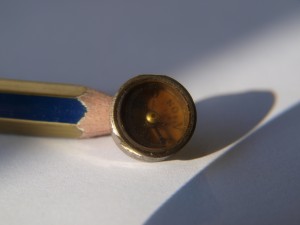
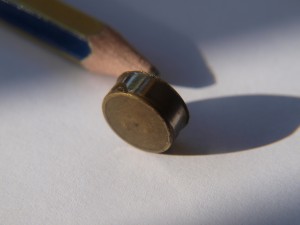
Unidentified escape compass
This compass is supposedly OSS issue, although everything advertised as OSS issue should be taken with a large pinch of salt. It does come from the States and the compass rose is in English (N-E-S-W), but that’s all we can be sure of. The four tiny pentagons on the compass rose are more likely of American than British origin, but that’s just speculation. With a common escape compass next to it for comparison, we see that what most distinguishes this type from other escape compasses is its smaller size. The diameter is 0.425″ (10,8 mm), the height is 0.154″ (3,9 mm). Also unusual is its aluminium body instead of brass. This may indicate interbellum or early war issue, because the early British escape compass mentioned above was also fashioned out of aluminium. In any case, late war is unlikely because at that time all countries rationed aluminium in favour of aircraft production. As with most brass models, the rim of the aluminium case was crimped over the rim of the glass cover, thus closing the compass. The card in compass rose is also unusual, as other escape compasses had the arrow and the compass rose integrated into one moving card with dots indicating North. Here, compass rose and arrow are seperate, as on traditional field compasses. If you take a close look at the compass rose, you will see that it was printed on thin aluminium foil, which was then pressed into the case, so that its sides reached up until the top rim, just below the glass cover. Looking even more closely, you can see that the compass arrow pivots on a narrow triangle cut into the thin sheet aluminium compass rose, which was folded vertically to a 90 degree angle. The compass arrow itself is a sheet steel diamond shape with a hole at its center. The arrow is half blued, with the blueing completely intact, but the rest of the steel has slightly corroded. This is why you can hardly see that at its center there is a small brass knob, because the corroded steel almost has the same colour as the brass knob. It is on this knob that the arrow actually pivots.
Another unidentified escape compass
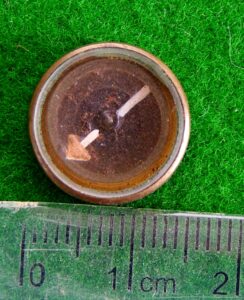 Chris Chettle from the UK sent me photos of this escape compass I have never seen before.
Chris Chettle from the UK sent me photos of this escape compass I have never seen before.
It’s 15mm wide and only seems to have one big white arrow with a luminous paint tip. The glass has a beveled edge and is flat, not domed. The brass casing looks similar to the other British escape compasses, with a small dimple at the bottom, from the metal turning tool, no doubt.
Does anyone have more information about this variation?
Canadian escape compasses
These photos were sent to me by Michel Perrier from Canada. The compasses came from the estate of an RCAF pilot. The exact dimension are 15,15mm in diameter for the larger one and 11,60mm for the smaller one. Both compassses are 4,75mm high and are made of brass with a non-ferromagnetic material bottom piece. Maybe someone has seen this type before and can identify them as RCAF issue or other?
Cuff link escape compass
Peter Yates sent me these photos of a typical RAF escape compass like the ones seen at the top of the page, but hidden inside cufflinks. You had to scratch off the paint to discover the compass. I had seen these before, but usually the paint has been completely stripped off. This example clearly demonstrates its purpose.
Razor blade escape compass
Peter Yates also sent me photos of his collection of razor blade compasses by six different manufacturers, all based in Sheffield during WW2. The blades would have been floated on still water and when settled, the beginning of the lettering end of the blade points North. They still work. As well as being issued to servicemen, they were also included in Red Cross food parcels sent to Prisoners of War. Fleet was a well-known company and had had a contract to supply (ordinary) razor blades to the British armed forces for many years. The Cheerio was made by the Wafer Razor Blade Company and it is widely believed it was designed as an insult to unsuspecting prison camp guards!
Credits
Thanks to Dave Hirsch for letting me use his description of his own collection and to Henri Van Meel for photographs of his collection.
You can contribute too:
This article describes the variety of escape compasses that I know of. You are welcome to contribute with any additional information that you may have.
Links
The National Ex-Prisoner of War Association
Royal Air forces Escaping Society
Royal Air Forces Ex-POW Association
The Great Escape Memorial Society
Royal Air Forces Escaping Society Museum
Related articles
Escape maps & map cases (I am still working on this. It wil be ready by the end of the year.)



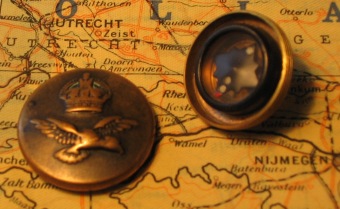
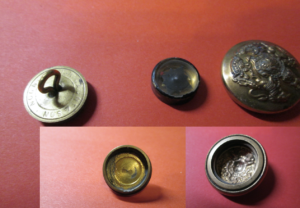

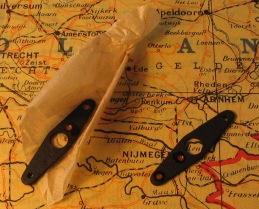
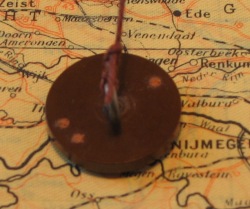
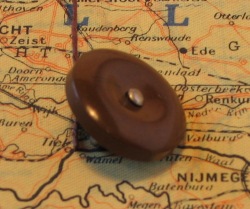
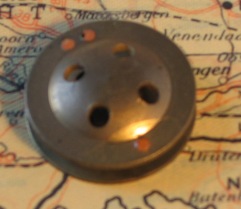



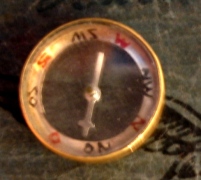
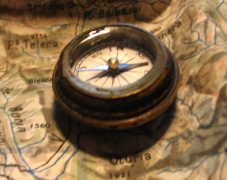



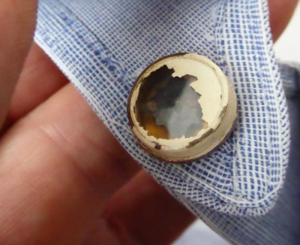
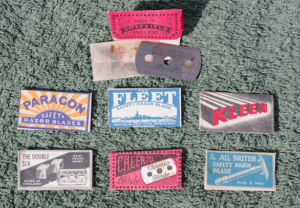
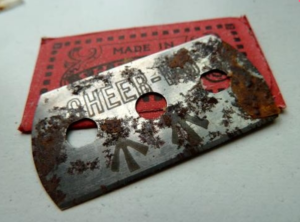

I have one of those mineature pill box escape compasses in pristine condition.
Identical to the one in your photo. I’d like to know it’s value. Can you help??
Thanks, Steve
Hi Steven, I got mine 7 years ago for about $40. They don’t come up for sale or auction as much as the regular escape compasses, so I’d say $75 is a fair price, maybe more.
I have a compass that I’m trying to ID. It’s .1/2″ dia and 1/4″ high. It’s brass I think with glass and seems liquid filled. If I sent you pictures would you help?
Thanks,
Yes, please send pictures and I will look at them for you.
I purchased General Clayton Bissell’s (US Air Force) personal collection of escape compasses on ebay. The smallest compass in the collection measures 3/16 inch diameter.
Michael
Hi Michael,
I would be very interested to see a photo of that collection, and that small compass in particular. Not necessarily to put on this site, unless that’s OK with you.
Regards,
Wouter
An elderly neighbour of mine has just shewn me a compass in a button which I had heard of but never seen before.It was part of her husband’s kit, he was in 98/72 Medium Battery R.A. May I943. Can you give her any further information? Kind Regards John Burls.
If you can send me photos, I’d be glad to have a look at it for you.
Photos sent,. comments very welcome and idea of value for neighbour. Many thanks.jb
Hi John, I got the photos. This is a tunic button compass like the one listed in my article. JR Gaunt was an insignia manufacturer in London and many insignia, also American, bear their hallmark. This button seems to have the British royal coat of arms (see ‘Dieu et mon droit’ on the scroll). I don’t know which branch of the service, or which unit would have used these buttons. Such tunic button compasses were made with negative thread heads at first, and later on a positive threads after the Germans had caught on to the idea. The compass inside is the most common type, but excellently preserved. A nice piece!
The button belonged to, so presumably was worn by, her husband, who as she told me was in 98/72 medium battery Royal Artillery in 1943. I have copied your comments and will give them to my neighbour tomorrow. My father was Brigadier J.A.E. Burls C.B.E., T.D., A.M.I.Mech.E, and ran the engineering side of A.A command, so as a young lad I often went with him in my A.T.C. uniform, especially during the V.1 attacks, around gunsites. And when two V.Is virtually blew much of our house off we moved down to Frinton on Sea on the East coast, and within days found ourselves under the flightpath of more V.1s launched from under the wings of Heinkel 111s. Many thanks for your interest. Kind regards jb (Sent pics to several friends but none had ever seen such a button before, and they showed great interest in them. Referred them to your site).
Photos sent. Did you receive them?
hello, i just found this escape compasses at this link :
http://www.leboncoin.fr/collection/386328782.htm?ca=14_s
i think i that there is no picture of this model on your website. The size of the coins is 16.25mm for his diameter.
That’s nice, another type of escape compass. New ones keep turning up. Thanks!
i have a money purse that you might finf interesting for your article. what i is your email ?
I have a R A F battle blouse buckle toothed compass the same as on this page 12 pictures down below the 4 buttons on the map could you tell me the approximate value please.
Regards George
Hi George, that’s a great find you have there. I haven’t seen any for sale since I bought mine, so I don’t have much of a reference, but this does mean that they are very rare. I believe I paid something like 125EUR for it. I hope this helps.
Hi there. My daughter has in her possession an escape compass…we thought nothing of it but decided to google it. Its an F Barker and Sons escape compass…it also has London on it. It has all the copper points and colors etc inside as the pictures of the real ones. Not sure how you tell if its a fake . Curious to if this is something of value or a rare item. I want to know if its something to be cherished or simply a toy. Thanks.
I’d be happy to have a look at for you. You can send photos to paratrooper.be@gmail.com
Kind regards,
Wouter
I havean unidentified escape compass whot is it value
If you can send me photos of front and back and the dimensions, I can have a look at it for you.
Hallo ben de gellukige bezitter geworden van een broek knop compad dank zy uw site heb. Ik het kunnen idetifiseren dank u
Bedankt om te laten weten!
Pingback:Quick Fact: During WW2, allied pilots, paratroopers, and commandos were given "Asshole... - Quick Facts
Hi
I have a comb with a swinger escape compass contained within it (have an x-ray image of it); the comb is missing a number of teeth – do you think a collector would be interested in the comb with missing teeth and if so what sites would be good to put it on? I believe this to be a RAF escape comb that my grandfather had issued to him when he flew with the Pathfinders Squadron which was part of bomber command of the British RAF.
Regards Penny
Hello Penny, that’s very interesting, and I have seen one sold on eBay before. I think it can fetch a few hundred euros there. If you can, try listing it on the .com site.
Id be interested in this
Best david
I remember as a very young child my father letting me break open a small brown and green tortoiseshell compass comb . The following Christmas he got another one out for me to break the compass out again. What a waist of memorabilia !
He was a W/T in SOE working in Yugoslavia and Italy.
I you have any photos or X-ray photos of such items, I would be happy to purchase copies from you.
My dad, Richard E. Day, flew a B-17 for the RAF. The only stories he told about the war were humorous ones. That included the “ass hole” compass. Currently there is much talk about politicians who have lost their moral compass. No. They are not lost, just hiding away where the sun never shines.
Hi there i have a friend selling an escape compass in a raf button and want to know if you can help me tell if it’s fake or real
Can I send you some photos??
Hi Olly, we covered this by email in the meantime. Your pictures looked good and the button is threaded. Kind regards, Wouter
Pingback:Compass Pretending to be a Button – www.johnwinter.blog
Hi John, just saw your article. Thanks for your credit! I do hope you will one day dig up one of these buttons. Or maybe some other secret issue item. Kind regards, Wouter
I have a British Army ‘escape and rescue’ tunic button with compass. Do you want me to send photographs ?
Jim.
jimsadler25@gmail.com
Yes, sure Jim. I will send you an email so you can reply to that. Thanks
Hi there, I have a tiny compass, with what I believe are Chinese symbols as well as N S E W. I identified one as meaning East in Chinese. On the other side of the compass is a fake watch face with gold painted hands and Roman numerals. The case looks like brass with glass covers each side. There are two small holes on the side and one small hole opposite. It is 1.7cm in diameter and 1cm thick. If you could possibly email me I can send over some photos. I’ve not found a similar one googling yet.
Hi Amanda, thank you for sharing these pictures. I have never seen one like this before. It looks very neat, but I think it’s a toy or trinket rather than an escape compass. Actually, the small puncture on the side might be from an attachment to a necklace or something.